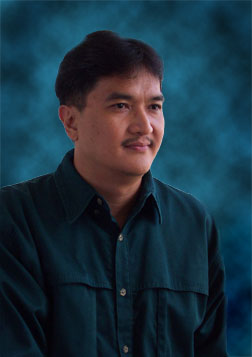Part Two B - Facial Angles
by Chuck Gardner
Two-thirds
 A 2/3 view of the face is created by turning
the face away from the camera just to the point at which the skin visible at the
side of the far eye disappears from view. When this is done the shape of the far
eye and cheekbone become apparent and make the face appears more three
dimensional and thinner. In general the 2/3 facial angle with short lighting is
the most esthetically pleasing for most subjects, especially Asians with wide
flat faces. It gives the face dimension and puts the highlights on the front of
the face, which is where you want the viewer's eye to go first. Watch movies
with an eye for the lighting and facial angles and you'll notice that for 95% of
the close-ups the actors will be in an exact 2/3 view of the face in which the
with short lighting illuminating the front of the face and just enough fill on
the to make the shadow detail visible, but not distracting. Often actors,
especially those in old black and white films, will walk across a room without
out once losing that perfect facial angle and lighting. A 2/3 view of the face is created by turning
the face away from the camera just to the point at which the skin visible at the
side of the far eye disappears from view. When this is done the shape of the far
eye and cheekbone become apparent and make the face appears more three
dimensional and thinner. In general the 2/3 facial angle with short lighting is
the most esthetically pleasing for most subjects, especially Asians with wide
flat faces. It gives the face dimension and puts the highlights on the front of
the face, which is where you want the viewer's eye to go first. Watch movies
with an eye for the lighting and facial angles and you'll notice that for 95% of
the close-ups the actors will be in an exact 2/3 view of the face in which the
with short lighting illuminating the front of the face and just enough fill on
the to make the shadow detail visible, but not distracting. Often actors,
especially those in old black and white films, will walk across a room without
out once losing that perfect facial angle and lighting.
Profile  The rule of "eyes and ears" for profiles is
"just one". If you've got more that one ear or eye showing in the photo its not
a good profile. Since the object closest the lens in a profile view is the ear,
it will be a visual distraction. Eliminate the distraction by using high
contrast short lighting with minimal fill, which will put the ear into the
shadows. When lit in this manner there should be a highlight from top to bottom
along the center line of the face (forehead, nose, chin) and a triangle of light
falling on the eye and cheek nearest the camera. The rule of "eyes and ears" for profiles is
"just one". If you've got more that one ear or eye showing in the photo its not
a good profile. Since the object closest the lens in a profile view is the ear,
it will be a visual distraction. Eliminate the distraction by using high
contrast short lighting with minimal fill, which will put the ear into the
shadows. When lit in this manner there should be a highlight from top to bottom
along the center line of the face (forehead, nose, chin) and a triangle of light
falling on the eye and cheek nearest the camera.
Goto Next Page > Goto < Previous Page > Goto Class Outline |